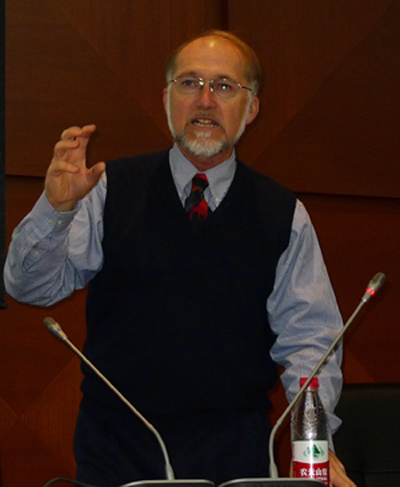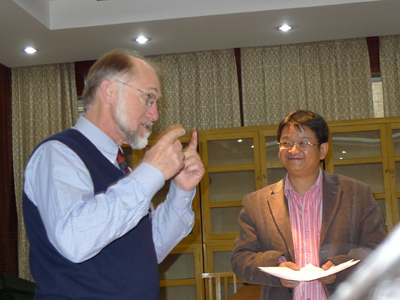
Greg Greenwood讲座中

Greg Greenwood与杜发春

讲座内容示意图

Greg Greenwood与中国学者合影
2010年11月23日,瑞士伯尔尼大学地理研究所山地研究基地主任格雷戈里•格林伍德(Greg Greenwood)博士应邀访问中国社科院民族所,并做了关于在青藏高原地区进行多学科研究的研究框架和研究方法的讲座。格林伍德先生说,如何运用全球土地计划的多学科研究策略以及地理信息系统的理念和技术,在青藏高原地区进行涵盖自然科学和社会科学的多学科研究,是他今天来社科院民族所讲座的原因,社会科学家尤其是人类学家民族学家可以在“第三极”研究中发挥更大更好的作用。
本次讲座由社科院民族所福特基金资助项目《三江源生态移民研究》课题组主办,项目负责人杜发春老师主持了讲座并宴请了格林伍德博士。北京师范大学环境学院董世魁教授,中央民族大学王朝晖教授,社科院民族所张继焦、丁赛、易华、马宗洁、杜倩平、阿迪娜、张小敏等来自不同学科的专家学者共15人聆听了讲座并与格林伍德博士进行了深入交流。参加讲座的中国学者表示,格林伍德博士的理论框架新颖,研究内容宏大,逻辑严密,研究方法独特,启示和借鉴较多。当然,如何在青藏高原开展如此规模宏大的研究项目,面临的困难也是显而易见的。
格林伍德先生是应中国科学院青藏高原研究所的邀请来华进行访问研究并顺访中国社科院民族所的。目前,中国科学院青藏高原研究所正在开展一项题为“第三极环境计划”(Third Pole Environment,TPE)重大项目的论证和研究,由中国科学院青藏高原研究所所长姚檀栋院士主持,旨在研究第三极的环境演化问题。“第三极地区”(Nature 454, 393-396, 2008)是一个面积大于500万平方公里、以青藏高原和喜马拉雅山脉为中心的地区,拥有世界上除南北极之外最大的冰储量,其冰川数量超过46000条并且冻土面积广袤。“第三极地区”亦称为“亚洲水塔”,其冰川孕育着亚洲几大河流,成为维系10几个国家15亿人生活的重要水源。TPE于2010年10月下旬在尼泊尔首都加德满都召开了“第二次资深专家研讨会”,研究这一区域的科学家们展示了最新的研究成果、讨论了最紧迫的科学问题、同时提出了一系列措施来应对这些科学问题。
讲座内容可以分为两个部分:第一部分,全球土地项目的多学科研究计划及内容;第二部分,我们怎样运用全球土地计划的多学科研究策略以及地理信息系统的理念和技术,在青藏高原地区进行涵盖自然科学和社会科学的多学科研究。以下是讲座的概要:
第一部分,全球土地计划的多学科研究策略及内容
山地研究基地(MRI)采用全球土地项目(GLP)制定的多学科合作的科学计划作为自己的研究框架。这个科学计划是根据2005年山区全球性变化项目(或称为GLOCHAMORE)——一个受欧盟第六框架的资助的项目,山地研究基地是它的科学项目管理机构——完成的研究策略报告制定的。这个科学计划提出了山区研究界认为应在山区推行的10大主题下40多个重点研究课题,并应该进行跨学科的长期研究,从而达到真正了解人地系统交互作用的目的。这十大主题是:
1)气候 Climate,
2)土地使用的变化 Land Use Change,
3)冰冻圈 Cyrosphere,
4)水文系统 Hydrologic Systems,
5)生态系统 Ecosystem Function,
6)生物多样性及生态系统结构 Biodiversity and Ecosystem Structure,
7)危险灾害 Hazards,
8)害虫和疾病 Pests and Diseases,
9)经济Economies,
10)机构Institutions.
山地研究基地(MRI)使用全球土地项目科学计划中的这个图表(见下图)作为联系各个学科的框架。
全球土地项目从这个研究计划框架中找出了三大研究主题。第一大主题,见图表中的绿色箭头部分,土地系统的动态变化;第二大主题, 见图表的红色箭头部分,土地系统变化的后果;第三大主题,见图表中蓝色箭头部分,土地可持续利用的综合分析和模型。每个大主题下都包含了一系列关键问题:
主题 1: 土地系统的动态变化
1.1: 全球化和人口变化有怎样的影响
1.2: 土地管理决策及实践的变化如何影响到生物地球化学,生物多样性,生物物理特性,如何扰乱陆生生物和淡水生物的生态系统?
1.3: 大气,生物地球化学,生物物理尺度的全球性变化如何影响生态系统结构与功能?
主题2: 土地系统变化的后果
2.1: 在地球自然与人文系统的综合作用下,生态系统发生了哪些关键的变化?
2.2: 生态系统结构功能的改变怎样影响到生态系统的服务供应?
2.3: 生态系统服务如何与人类发生联系?
2.4: 面对生态系统服务供应的变化,不同自然人文环境下,人类怎样不同程度地应对的?
主题 3: 土地/资源可持续利用的综合分析和模型
3.1: 土地系统改变的关键途径是什么?
3.2: 在人与环境的相互作用下,土地制度的脆弱性和抗灾能力对灾害和扰动的有怎样不同的响应?
3.3: 各种体制的不同安排如何造成资源可持续利用,或者不能可持续利用的区别?
第二部分,我们怎样运用全球土地计划的多学科研究策略以及地理信息系统的理念和技术在青藏高原地区进行多学科研究
全球土地计划(GLP)的分析框架通过整个系统功能相互联系的一系列有说服力的论点,将生物地球物理和社会学科各个门类都收纳到其中。但另一方面它有个不足之处,就是没有做空间上的界定。当然其中的各个要素都存在于空间,但它与空间维度没有明显相关性。可以想见,这个人-地交互作用的多学科图表既可以应用于一个农庄,也可以应用到整个第三极。为了切实实施这一多学科科学计划,我们将需要知道这个系统如何在一个具体的地理空间范围内进行描述的。
在过去的30年中,地理信息系统和遥感数据使我们能够获得不只是类型化粗略的信息,而是地球表面所有完整信息。此外,它支持了那些难以测量的空间变量地理模型的发展。
如果全球土地计划(GLP)的分析计划是能够描述整个土地系统互动的一种方法的话,那么地理信息系统是另一种能够描述整个土地系统互动的方法。这两种方法使用的语汇不同,但在提到的其实是同一个对象。
格林伍德博士简介:
格林伍德博士自从2004年6月起担任山地研究基地(Mountain Research Initiative,简称 MRI)的执行主任。他是加州大学戴维斯分校生态学博士,科罗拉多州立大学草原学硕士,米德尔伯里学院的地理学学士。他在担任山地研究基地主任之前,曾担任加利福尼亚州资源秘书处的科学顾问,和加州林业部气候及生物能源领域的科学顾问。在加州政府任职期间,他所涉及到的问题有:气候变化,尤其是为减轻和适应气候变化的政策的制定,自然资源管理——在加州主要涉及到森林的健康、森林火灾、濒危物种,生物质能源这几个方面。在这段时间里,他代表加州政府主持了内华达山脉生态系统项目,这个项目为美国国会提供多学科视角的山脉评估报告。在1990之前,他主要在非洲、南亚从事国际自然资源管理工作。格林伍德博士精通英、法两种语言。
山地研究基地简介:
山地研究基地(MRI)是经国际地圈生物圈计划(IGBP)和国际全球变化生物圈计划(IHDP)这两个主要的全球变化研究保护组织的成员们讨论后成立的。曾经受到联合国教科文组织人类与生物圈项目(UNESCO_MAB)、全球陆地观测组织(GTOS)的资助。从2004年起,受到瑞士国家科学基金的资助。
How Can We Implement Interdisciplinary Earth System Science on the Third Pole? Dr. Greg Greenwood visited IEA at CASS
Dr. Greg Greenwood, the gave a lecture on
November 23, 2010, Dr. Greg Greenwood, Exe-cutive Director of the Mountain Research Initiative, University of Bern, Switzerland gave a lecture at the Institute of Ethnology & Anthropology, CASS. The topic is how to How Can We Implement Interdisciplinary Earth System Science on the Third Pole? This seminar was chaired by Professor DU Fachun from CASS, Project Director, Research on Ecological Resettlement in Sanjinagyuan Area of the Qinghai-Tibetan Plateau, funded by the Ford Foundation. This project is to conduct field research and provide feedback on the government s strategy of protecting grasslands in southern Qinghai Province.
The attendeers of this roundtable are: Prof. Dong Shikui from Beijing Normal University, Professor Wang Zhaohui from the Minzu University of China, Prof. Zhang Jijiiao, Dr. Dingsai, Dr.Yihua, Dr. Ma Zongjie, Du Qianping, Zhang Xiaomin, and Adi na from IEA, listened to the lecture and the followed discussion.
Dr. Greg Greenwood is the Exe-cutive Director of the Mountain Research Initiative, University of Bern, Switzerland. In this lecture, he introduced an approach to interdisciplinary research derived from that of the Global Land Project, then discussed how we might implement this approach in the Qinghai-Tibetan Plateau using GIS concepts and technologies. His objective is to create a framework within which multiple researchers from many disciplines could collaborate over the long term to understand the coupled human-earth system in the mountains of Monsoon Asia.
The outline of Dr. Greg s lecture can be divided into two parts, PART I GLP approach, PART II How can we adapt the GLP approach to the Third Pole using GIS concepts and technologies? General concepts is as the followings:
PART I GLP approach:
The MRI used the Global Land Project (GLP) Science Plan as a framework by which to link together disciplinary studies, which is based on a research strategy report in 2005 by the Global Change in Mountain Regions (or GLOCHAMORE) project, a European Union FP6 Support Action, for which MRI is responsible for the project s scientific project management. The research strategy report outlined more than 40 priority research topics under 10 headings that the mountain research community thought should pursued in mountains regions within an interdisciplinary context in order to understand truly the coupled human-earth system. The 10 headings are:
1)Climate,
2)Land Use Change,
3)Cyrosphere,
4)Hydrologic Systems,
5)Ecosystem Function,
6)Biodiversity and Ecosystem Structure,
7)Hazards,
8)Pests and Diseases,
9)Economies,
10)Institutions.
The MRI used this diagram taken from the Global Land Project Science Plan as a framework by which to link together disciplinary studies.
The Global Land Project saw three major research themes with this scheme. The first, shown with green arrows, involves the dynamics of land systems. The second, shown with red arrows, involves the consequences of land system change. And finally, the third, shown with blue arrows, involves land/resource sustainability. Each of these themes contains within it a set of key questions:
Theme 1: Dynamics of Land Systems
1.1: How Do Globalisation and Population Change Affect
1.2: How Do Changes in Land Management Decisions and Practices Affect Biogeochemistry, Biodiversity, Biophysical Properties and Disturbance Regimes of Terrestrial and Freshwater Ecosytems?
1.3: How Do the Atmospheric, Biogeochemical and Biophysical Dimensions of Global Change Affect Ecosystem Structure and Function?
Theme 2: Consequences of Land System Change
2.1: What are the Critical Feedbacks to the Coupled Earth System from Ecosystem Changes?
2.2: How Do Changes in Ecosystem Structure and Functioning Affect the Delivery of Ecosystem Services?
2.3: How are Ecosystem Services Linked to Human Well-being?
2.4: How Do People Respond at Various Scales and in Different Contexts to Changes in Ecosystem Service Provision?
Theme 3: land/resource sustainability
3.1: What are the Critical Pathways of Change in Land Systems?
3.2: How Do the Vulnerability and Resilience of Land Systems to Hazards and Disturbances Vary in Response to Changes in Human–Environment Interactions?
3.3: how institutional arrangements make the difference between trajectories that are sustainable and those that are not?
PART II How can we adapt the GLP approach to the Third Pole using GIS concepts and technologies?
The GLP analytical scheme thus draws together a wide range of biogeophysical and social disciplines through a compelling rhetoric of whole system function, but it is on the other hand spatially undefined. The elements within it certainly exist within space but it is not obvious a priori what spatial scales are relevant. The diagram could conceivably applied to one farmstead or to the entire Third Pole. In order to actually implement this scheme, we will need to how this system description actually manifests within geographic space.
Over the last three decades GIS and remotely sensed data have allowed us to to obtain not just representative, but rather complete information about the surface of the earth. In addition, it has supported the development of spatial models for geographic variables that are difficult to measure.
If the GLP analytical scheme is one way to characterize the entire land system, then so to is GIS. These two approaches use different vocabularies but are in fact referring to the same object.
Brief Introduction to Dr. Greenwood:
Dr. Greenwood has served as MRI s Exe-cutive Director since June 2004. He has a Ph.D. in Ecology from the University of California at Davis, an M.S. in Range Science from Colorado State University and a B.A. in Geography from Middlebury College. Prior to MRI, he served as Science Advisor to the Resources Secretary of California and Climate and Bioenergy Advisor for the California Department of Forestry. The issues Dr. Greenwood dealt with during his time in California were climate change, especially policy development for both mitigation and adaptation, and natural resource management, which in California is an amalgam of forest health, wildfire, endangered species and biomass energy issues. During this time, he represented the state on the Sierra Nevada Ecosystem Project, a major interdisciplinary assessment of the mountain range for the US Congress. Prior to 1990, he worked in international natural resource management, principally in Africa and South Asia. He is fluent in English and French.
The origin of Mountain Research Initiative (MRI):
MRI arose out of discussions among members of the two major umbrella organizations for global change research, the IGBP and the IHDP. It has been endorsed by UNESCO_MAB, GTOS, and by the Global Land Project of the newly founded Earth System Science Partnership. The MRI has been supported since 2004 by a grant from the Swiss National Science Foundation.
(reported by ZHANG Xiaomin)
The MRI used this diagram taken from the Global Land Project Science Plan as a framework by which to link together disciplinary studies.
The Global Land Project saw three major research themes with this scheme. The first, shown with green arrows, involves the dynamics of land systems. The second, shown with red arrows, involves the consequences of land system change. And finally, the third, shown with blue arrows, involves land/resource sustainability. Each of these themes contains within it a set of key questions:
Theme 1: Dynamics of Land Systems
1.1: How Do Globalisation and Population Change Affect
1.2: How Do Changes in Land Management Decisions and Practices Affect Biogeochemistry, Biodiversity, Biophysical Properties and Disturbance Regimes of Terrestrial and Freshwater Ecosytems?
1.3: How Do the Atmospheric, Biogeochemical and Biophysical Dimensions of Global Change Affect Ecosystem Structure and Function?
Theme 2: Consequences of Land System Change
2.1: What are the Critical Feedbacks to the Coupled Earth System from Ecosystem Changes?
2.2: How Do Changes in Ecosystem Structure and Functioning Affect the Delivery of Ecosystem Services?
2.3: How are Ecosystem Services Linked to Human Well-being?
2.4: How Do People Respond at Various Scales and in Different Contexts to Changes in Ecosystem Service Provision?
Theme 3: land/resource sustainability
3.1: What are the Critical Pathways of Change in Land Systems?
3.2: How Do the Vulnerability and Resilience of Land Systems to Hazards and Disturbances Vary in Response to Changes in Human–Environment Interactions?
3.3: how institutional arrangements make the difference between trajectories that are sustainable and those that are not?
PART II How can we adapt the GLP approach to the Third Pole using GIS concepts and technologies?
The GLP analytical scheme thus draws together a wide range of biogeophysical and social disciplines through a compelling rhetoric of whole system function, but it is on the other hand spatially undefined. The elements within it certainly exist within space but it is not obvious a priori what spatial scales are relevant. The diagram could conceivably applied to one farmstead or to the entire Third Pole. In order to actually implement this scheme, we will need to how this system description actually manifests within geographic space.
Over the last three decades GIS and remotely sensed data have allowed us to to obtain not just representative, but rather complete information about the surface of the earth. In addition, it has supported the development of spatial models for geographic variables that are difficult to measure.
If the GLP analytical scheme is one way to characterize the entire land system, then so to is GIS. These two approaches use different vocabularies but are in fact referring to the same object.
Brief Introduction to Dr. Greenwood:
Dr. Greenwood has served as MRI s Exe-cutive Director since June 2004. He has a Ph.D. in Ecology from the University of California at Davis, an M.S. in Range Science from Colorado State University and a B.A. in Geography from Middlebury College. Prior to MRI, he served as Science Advisor to the Resources Secretary of California and Climate and Bioenergy Advisor for the California Department of Forestry. The issues Dr. Greenwood dealt with during his time in California were climate change, especially policy development for both mitigation and adaptation, and natural resource management, which in California is an amalgam of forest health, wildfire, endangered species and biomass energy issues. During this time, he represented the state on the Sierra Nevada Ecosystem Project, a major interdisciplinary assessment of the mountain range for the US Congress. Prior to 1990, he worked in international natural resource management, principally in Africa and South Asia. He is fluent in English and French.
The origin of Mountain Research Initiative (MRI):
MRI arose out of discussions among members of the two major umbrella organizations for global change research, the IGBP and the IHDP. It has been endorsed by UNESCO_MAB, GTOS, and by the Global Land Project of the newly founded Earth System Science Partnership. The MRI has been supported since 2004 by a grant from the Swiss National Science Foundation.
(reported by ZHANG Xiaomin)